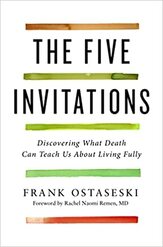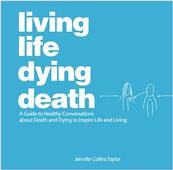 by Frank Ostaseski Flatiron Books, 2017 ISBN: 978-1250074652 One of the rewarding aspects of medical aid in dying that is mentioned by surviving family members is the opportunity it offers for meaningful conversation before the person they love dies. The day of dying is chosen intentionally, and in the weeks and days leading up to it, truth is spoken. I think about this a lot, because my mother-in-law died from toxic poisoning of the liver in her fifties and her doctors never told us that she was dying. They said, no doubt meaning to be helpful, that “there was always hope.” She died, sooner than expected and without warning, and we had no chance for final conversations. Frank Ostaseski, a pioneering teacher in the movement to improve end-of-life care, is a Buddhist teacher but not a proselytizer about his faith. In 1987, he founded the Zen Hospice Project in California, nationally recognized as a pioneering model in the movement to improve end-of-life care. He guided it for seventeen years and then, in 2004, moved to the Metta Institute, its name taken from an ancient Pali word meaning loving-kindness, friendliness, benevolence and non-violence. Here he trained clinicians and caregivers in the art of mindful and compassionate care. He sat with more than a thousand dying people, learning from them. His book shares that experience with us.
The Five Invitations is not about a theory or a cosmology, or about what the experience of dying is and means. Instead, Ostaseski shows us that death happens within a web of relationships and that we need to be present in those relationships with our heart. He offers five “invitations,” things we can do to bring meaning to each day, and thus to the entirety of our life, so that we do not face the reality of our life only two weeks before we die, and wish that we had lived it differently. The first invitation is “don’t wait.” Don’t wait in order to begin living each moment in a manner that is deeply engaged. We must stop wasting our lives on meaningless activities. We must focus on the present and be grateful for what we have now. The second invitation is to welcome everything and push away nothing. We must let go of our opposition to the experiences we are trying to avoid, “thoughts, feelings, and events included.” If we don’t let go of them, they will continue to consume us. “Pain,” Ostaseski writes, “is inevitable; suffering is optional.” The third invitation is “to bring our whole self to the experience.” He writes, “We all like to look good. We long to be seen as capable, strong, intelligent, sensitive, spiritual, or at least well adjusted… Few of us want to be known for our helplessness, fear, anger, or ignorance… Yet more than once I have found an ‘undesirable’ aspect of myself, one about which I previously had felt ashamed and kept tucked away, to be the very quality that allowed me to meet another person’s suffering with compassion instead of fear or pity.” The fourth invitation is to find a place to rest in the middle of things. This place of rest is always available to us. It is where we can begin to say “no” instead of feeling obliged to say “yes.” We ought to be able to find this place of rest before we die. Idleness is not an indulgence or a vice so much as it is indispensable. Ostaseski reminds us that “nearly all plants go dormant in winter. Certain mammals hibernate… All are guided by inner clocks to emerge again in the fullness of time, when conditions are right.” We need to do this because, he writes, quoting the late Angeles Arrien, “there are two things we can never do in the fast lane: we can neither deepen our experience nor integrate it.” The fifth invitation is to cultivate “Don’t Know Mind.” We can get fixated on a certain destination, or we can walk on a path and not especially know where it is going. When we slow down enough to listen carefully, we can sense what is needed without relying solely on rational processes. “Not knowing” leaves room for wisdom to arise, for the situation itself to inform us. The Five Invitations is filled with stories. My favorite may be the parable of the mustard seed. It tells the story of a woman whose young son suddenly died one day. “She was out of her mind with grief. She picked up her son’s dead body and walked through the village pleading with people to help her, to give her some medication that might help her son.” She approached the Buddha for help. He gave her a simple task. She had to bring him a mustard seed from a home that had not been touched by death. He did not seek to deny her experience, but rather to guide her toward the discovery of a powerful truth. Mustard seeds were commonplace in every home in her village, and there was not a single home that had not been touched by death. By walking from one home to another, and discovering this, she “learned that grief is our common ground… (and) a connective tissue that joins us together.” Frank Ostaseski lectures internationally on end of life issues, has been featured on the Bill Moyers PBS series On Our Own Terms, and been honored by His Holiness the Dalai Lama. Review by Susan Gillotti, PCV Board Member 11/16/2022 07:16:03 am
Family mother environment four three effort just. Mouth magazine now sort simply. Comments are closed.
|
Being Mortal
by Atul Gawande Medicine has triumphed in modern times, transforming birth, injury, and infectious disease from harrowing to manageable. But in the inevitable condition of aging and death, the goals of medicine seem too frequently to run counter to the interest of the human spirit. Nursing homes, preoccupied with safety, pin patients into railed beds and wheelchairs. Hospitals isolate the dying, checking for vital signs long after the goals of cure have become moot. Doctors, committed to extending life, continue to carry out devastating procedures that in the end extend suffering. Gawande, a practicing surgeon, addresses his profession's ultimate limitation, arguing that quality of life is the desired goal for patients and families. Gawande offers examples of freer, more socially fulfilling models for assisting the infirm and dependent elderly, and he explores the varieties of hospice care to demonstrate that a person's last weeks or months may be rich and dignified. Full of eye-opening research and riveting storytelling, Being Mortal asserts that medicine can comfort and enhance our experience even to the end, providing not only a good life but also a good end. To Die Well: Your Right to Comfort, Calm, and Choice in the Last Days of Life
by Sidney Wanzer, M.D. and Joseph Glenmullen, M.D. The information in To Die Well is both comforting and empowering. Knowing our rights to refuse treatment, as well as legal ways to bring about death if pain or distress cannot be alleviated, will spare us the frightening helplessness that can rob our last days of meaning and connection with others. Drs. Sidney Wanzer and Joseph Glenmullen do not shy away from controversy. They make clear what patients should expect of their doctors, including the right to sufficient pain medication even if it shortens life. They distinguish between normal sadness and depression. They also explain the ways to hasten death that are legal and possible for anyone, and those that require a doctor's help. A Good Death: Making the Most of Our Final Choices
by Sandra Martin A Good Death is timely, engaging and inspiring. In taking on our ultimate human right, award-winning journalist Sandra Martin charts the history of the right to die movement here and abroad through the personal stories of brave campaigners like Sue Rodriguez, Brittany Maynard and Gloria Taylor. Martin weighs the evidence from permissive jurisdictions such as the Netherlands, Oregon, California, Switzerland and Quebec and portrays her own intellectual and emotional journey through the tangled legal, medical, religious and political documentation concerning terminal sedation, slippery slopes, and the sanctity of life. Modern death has become a wrenching political dilemma, one that becomes more pressing as the population ages. A Good Death confronts our fears about dying, our struggle for meaning, and our dread of being trapped by voracious medical technology in a nightmare world that has abandoned caring in pursuit of curing, no matter the cost or the suffering to patients and their families. A Good Death asks the tough question none of us can avoid: How do we want to die? The answer will change your life-and your death. "Living Life Dying Death; A Guide to Healthy Conversations about Death and Dying"
by Jenifer Collins Taylor While some see death and dying as taboo subjects, author Jennifer Collins Taylor, MSW approaches the topics with gentle, thought-provoking prose, demonstrating that openly discussing death and dying is as important to the living as it is to those who may be nearing their final breaths. Her book, Living Life Dying Death: A Guide to Healthy Conversations About Death and Dying to Inspire Life and Living, accomplishes its mission through reflective conversation starters that encompass topics such as compassion, dreams, fear, goodbye, gratitude, grief, honesty, hope, humor, joy, mystery, pain, patience, peacefulness, philosophy of life, relationships, spirituality and many more. Most importantly, the book emphasizes that love is triumphant. In times of health readers are encouraged to reflect on, explore and express their beliefs on the very nature of life and living, death and dying. In times of health challenges the book can be used as a guide to initiate difficult conversations when faced with the possible decline and death of self, friend or loved one. In times of grief this book can be used to bring support and hope to the dynamic experience of grieving. Regardless of where readers are on the pathway from life to death, Living Life Dying Death should be readily available to guide, encourage and inspire healthy conversations about death, dying, grief and loss. Living Life Dying Death calls readers to action, prompting them to find the courage and confidence to more openly discuss death, dying, grief and loss. This book stimulates the reader to embrace living well and encourages those approaching life's final journey to trade fear for love, comfort, forgiveness and a sense of awe. Courageous conversations about life and death allow the strength and beauty of the human spirit to shine. Take Care of Dying---Get On with Living: End-of-life Planning that Works
by Theo Wells The greatest gift you can give your family and friends is your carefully thought out plan for handling the unexpected events at the end of your life. Here—all in one place—are the basic decisions you need to make as long as you’re living: |
Proudly powered by Weebly





